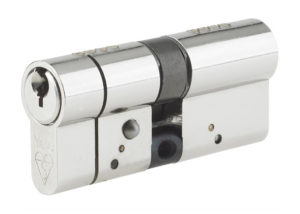Nightlatch – An old fashioned type lock that was common on front doors before the invention of deadlocks. The lock is mounted on the inside of the door and is usually brown in colour. These locks are not deadlatches.
Deadlatch – A lock that cannot be opened by slipping a piece of plastic (credit card etc) between the door and frame and manipulating the latch back to open the lock.
Deadlock – A lock that can be locked on both sides of the door. A deadlocked door can stop an intruder from entering by simply smashing a window and reaching in, or if they climb in through a window they’ll have to leave via the window, thus making it difficult to carry out items without raising suspicion.
It is not advisable to deadlock the inside of a door whilst inside.
Deadbolt – A Double cylinder deadbolt requires a key to lock it from the outside and the inside. This type of lock doesn’t automatically close when you pull the door shut behind you.
A deadbolt is not allowed to be installed on a unit front door.
Mortice Lock – This type of lock is mounted in a pocket cut into the edge of the door. The furniture is installed on the sides of the door.
This type of lock can look more classy, but the door needs to be a minimum thickness to avoid the chance of being weakened by the mortice (pocket cut out).
Key in Knob lock – The most common type of lock found on a unit or commercial premises front door. This type of lock has a knob or handle on both sides of the door and is usually locked by pushing a button or turning a knob on the inside handle.
Rim Lock – this refers to any type of lock that is ‘rim’ (surface) mounted onto the inside of the door.
Profile cylinder or Euro profile: A cylinder lock mechanism utilising a cam actuator. Used in a mortice lock, the inside and outside can both be key-operated or the inside can be provided with a thumb turn.

Latch – This is the part of the lock that actually protrudes from the door into the door frame/jamb, providing the physical means for securing the door. In some types of locks, this is often referred to as the ‘bolt’ or ‘tongue’.
Strike – A strke plate is mounted on the door frame for the latch to lock into.
Backset – is the distance from the edge of the door to the centre of the lock. The most common sizes are 60mm, 70mm or 127mm
Cylinder – A complete assembled barrel and shell, including pins (tumblers), springs, etc. Cylinders come in various shapes and sizes, predominately round or oval.
Barrel – The part of the lock that is turned by the key. The broach or keyway is cut into the barrel to hold the key in position. Only keys with the corresponding broach will enter that barrel. A barrel is also known as a ‘plug’.
Shell – this is the housing for the barrel which contains the springs and top pins.
Cam – This is the drive on the back of the cylinder that operates the lock. Cams are made in different configurations to operate different functions within the lock.
Tail – This part is the drive on the back of round cylinders and is usually held on with a circlip.
Pins or Tumblers – These are the parts that make up the different combinations in each lock. Each pin is matched with a cut in the key.

KA – Keyed Alike. Each lock will be keyed the same. Keyed Alike offers the convenience of using the same key on all your locks.
KD – Keyed Different or Random. Each lock is keyed to its own individual combination. The number of different key codes (combinations) varies widely by manufacturer, and lock design.
MK – Master Keyed. Each lock is set up to work with the master key and its own individual key. Master key systems can be designed so that each lock can be keyed up to operate with a number of predetermined keys.
Maison Keyed. All keys (different combinations) work the lock. The front door to a unit complex is quite often keyed this way. Each tennants key is different and wont work any other door, but all keys will operate the front door.



